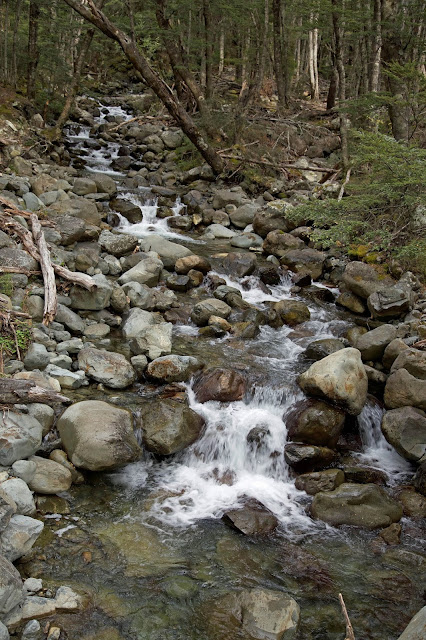 |
[View Down to Stony Bay] |
And in the morning, while
the wind’s still fresh, the sun is shining. After breakfast we learn that two
of the other walkers have arranged to be “jockeyed” out with the supply van. One
of them is unwell with a virus, and the prospect of the nearly 700m climb to
the rim of the old volcano has proved too much. Lynne has considered the same
option, but is determined to complete the circuit. We wish the others well,
hoist our packs, and start to walk out the only way we know how: one step at a
time.
 |
[Ready to Leave Stony Bay] |
The initial climb is
gradual, and through lush planted garden, but soon we’re climbing more steadily
through rough, regenerating bush. This is part of the Hinewai Reserve, 1250
hectares of Protected Private Land. Amid weedy species such as gorse and broom,
native ferns, shrubs and trees are slowly returning. The theory is that, if fire
and grazing animals can be excluded, the native plants, sheltered by the weeds,
will soon become dominant.
 |
[Weeds and Natives above Stony Bay] |
I confess I find this ugly to
walk through, and it seems a second-best way to achieve such a result (the best
being to leave it intact in the first place). But hindsight is a marvellous
thing, and by the time we reach some of the remaining intact forest, I warmly
applaud this effort to make good what was once here.
 |
[In the Beech Forest] |
The best of the remnant
beech forest is on the steepest slopes, surely because they were the most
difficult for 19th century tree-clearing techniques to reach. As we
sweat our way up through the forest, our warm applause soon become stunned awe.
The dominant red beech/Tawhai raunui (Nothofagus fusca), some of which are probably
several hundred years old, are a wonder to behold. Their dappled, deep green shade
gives both excuse to pause, and inoculation against some of the pain of the climb.
 |
[One of the Giant Red Beech Trees] |
As we ascend further, the
trees diminish in size and vary in species. Is it just me, or does everyone on
a climb like this think “and just around this corner we’ll break out into the
open tops”? The short answer is always “No!”. But thankfully the long answer is
eventually a relieved “Yes!!” On this occasion, the walking track breaks out
onto a 4WD track, and before too long we’re at the Tara Track shelter. We’ve
reached an altitude of 690m, and it’s taken us less than 3 hours. We celebrate
with our remaining cheese and bikkies, then wander along the now easy grade
track, through open tussock, to our descent point.
 |
[The Tussocky Tops] |
The rain has not only held
off, the skies have completely cleared. As we stand near the viewpoint above
Akaroa, the sky and the harbour seem to vie for the title of best blue. But not
all is straightforward. While descending is usually easier than ascending,
Lynne’s sore knee has found the opposite on the previous two days. We talk
about taking it slowly; stopping frequently; resting the knee as much as
possible. But it’s still with some apprehension that we start the long descent.
 |
[Above Akaroa: It's All Downhill From Here!] |
All of that makes it all
the more pleasing that we get to the bottom in little more than an hour, and
with virtually no knee issue. That’s not to say we’re not exhausted, and that we’re
not mightily pleased to see our car at Mt Vernon Lodge. But more than anything
we’re proud of completing our circuit of the headlands, cliffs, forests and
farms that make up the beautiful Banks Track. All that remains is to find a
little French café in Akaroa for a celebratory drink. And perhaps a pain au chocolat or two.


































